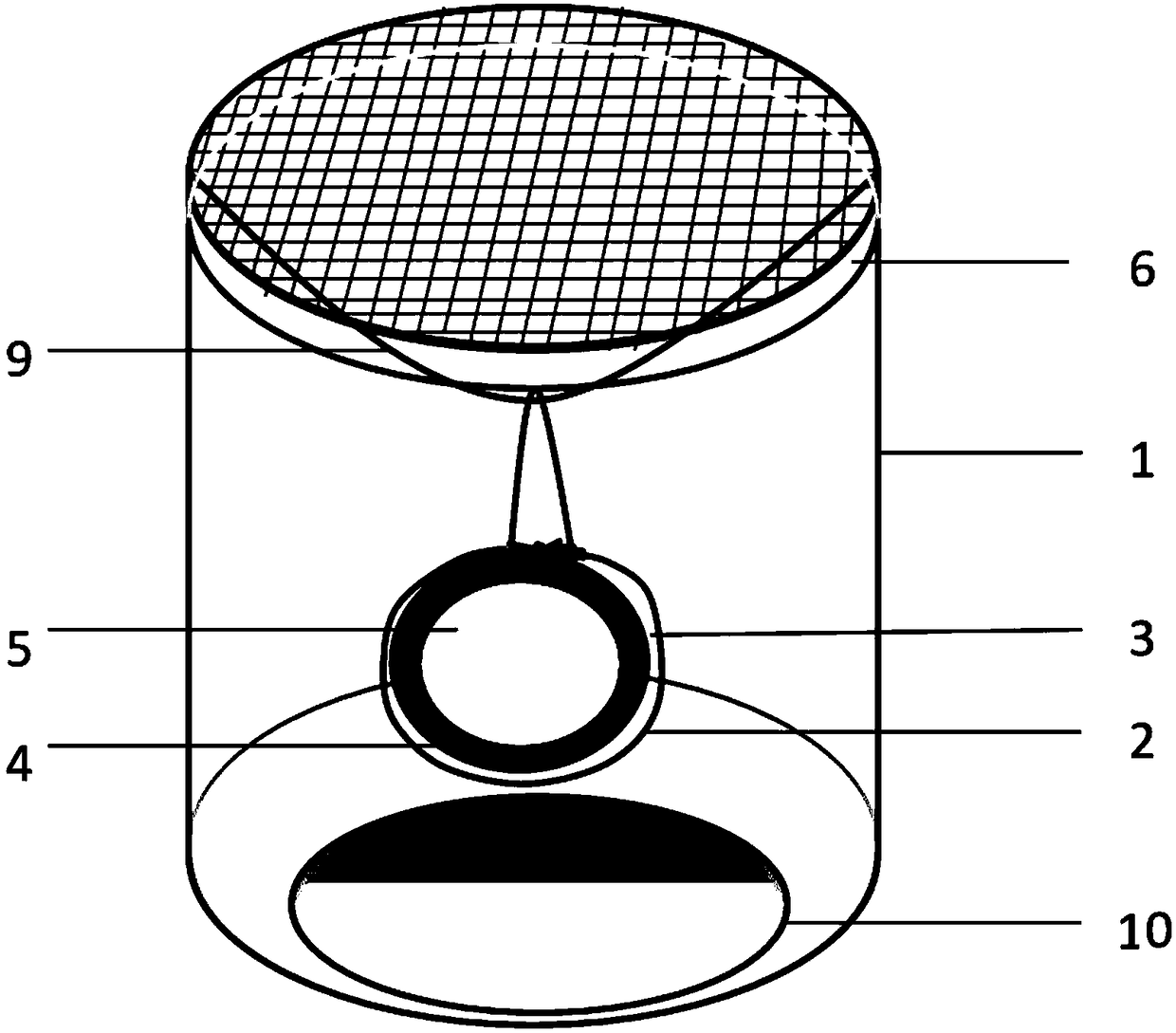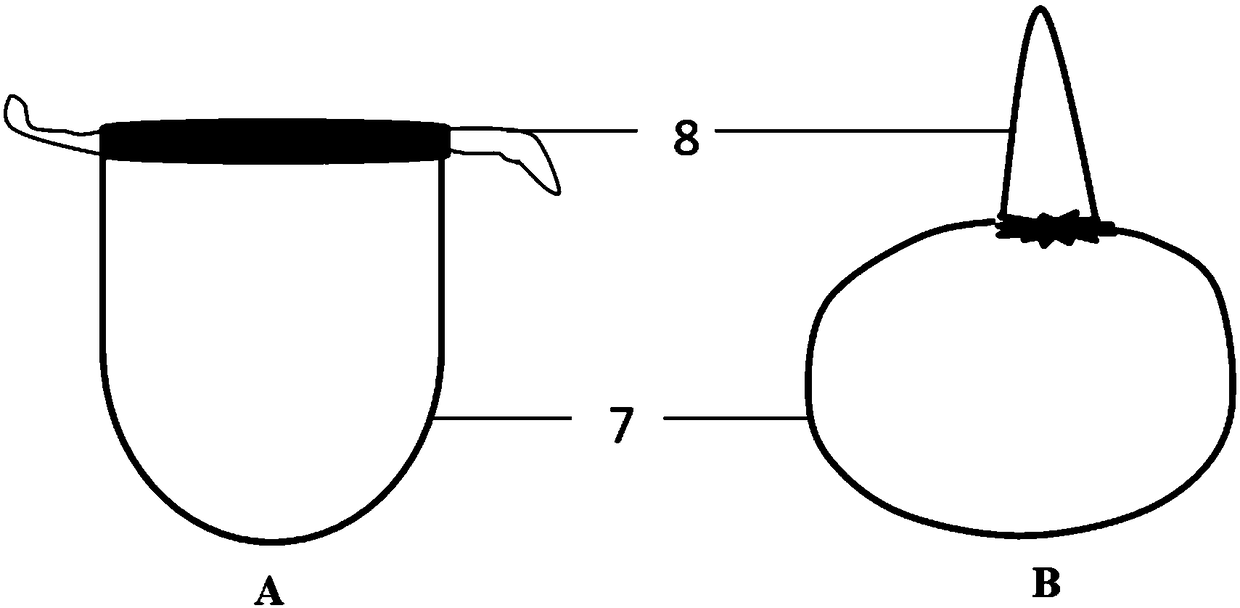Device and method for lab rearing of fruit fly parasitic wasps
A technology of parasitic wasps and fruit flies, which is applied in the field of plant protection, can solve the problems of high mortality of fruit fly parasitoids in indoor breeding, and achieve the effects of improving application value, reducing waste, increasing area and probability
- Summary
- Abstract
- Description
- Claims
- Application Information
AI Technical Summary
Problems solved by technology
Method used
Image
Examples
Embodiment 1
[0048] The method of indoor breeding of fruit fly parasitic wasps in this embodiment is based on Figure 1-2 The rearing device of the structure shown in is carried out, specifically including the following steps:
[0049] (1) Collect Drosophila melanogaster larvae and pupae in the field, place them in a cage in a breeding room with suitable conditions, and wait for them to emerge from parasitic wasps as a source of propagation; the conditions for controlling the artificial breeding are: breeding temperature 26± 1℃, relative humidity 50-60%, illumination time 16L: 8D;
[0050] (2) Preparation of artificial feed: weigh 120g of banana and 120g of apple, mix them and make a puree with a juicer; separately weigh 45g of banana corn flour, 22g of sucrose, 22g of yeast powder, and 1.5 of preservative (potassium sorbate) g. 9g agar, mixed with the prepared banana mash and apple mash, set aside;
[0051] Spread the prepared artificial feed on a 40cm wide and 65cm long tray, control the thic...
Embodiment 2
[0056] The method of indoor breeding of fruit fly parasitic wasps in this embodiment is based on Figure 1-2 The rearing device of the structure shown in is carried out, specifically including the following steps:
[0057] (1) Collect Drosophila melanogaster larvae and pupae in the field, place them in a cage in a breeding room with suitable conditions, and wait for parasitic wasps to emerge from them as insect species to be expanded; the conditions for controlling the artificial breeding are: breeding temperature 26±1℃, relative humidity 50-60%, light time 16L: 8D;
[0058] (2) Preparation of artificial feed: weigh 100g of banana and 130g of apple, mix them and make a puree with a juicer; separately weigh 40g of banana corn flour, 25g of sucrose, 20g of yeast powder, and 2g of preservative (potassium sorbate) , 8g agar, mixed with the prepared banana mash and apple mash, set aside.
[0059] Spread the prepared artificial feed on a 40cm wide and 65cm long tray, control the thicknes...
Embodiment 3
[0064] The method of indoor breeding of fruit fly parasitic wasps in this embodiment is based on Figure 1-2 The rearing device of the structure shown in FIG. 2 specifically includes the following steps:
[0065] (1) Collect Drosophila melanogaster larvae and pupae in the field, place them in a cage in a breeding room with suitable conditions, and wait for them to emerge from parasitic wasps as insect species to be expanded; the conditions for controlling the artificial breeding are: breeding temperature 26±1℃, relative humidity 50-60%, light time 16L: 8D;
[0066] (2) Preparation of artificial feed: Weigh 130g of banana and 100g of apple, mix them and make a puree with a juicer; separately weigh 50g of banana corn flour, 20g of sucrose, 25g of yeast powder, and 1g of preservative (potassium sorbate) , 10g agar, mixed with the prepared banana mash and apple mash, and set aside;
[0067] Spread the prepared artificial feed on a tray 30-50cm wide and 50-80cm long with a thickness of ...
PUM
| Property | Measurement | Unit |
|---|---|---|
| Diameter | aaaaa | aaaaa |
| Thickness | aaaaa | aaaaa |
| Mesh | aaaaa | aaaaa |
Abstract
Description
Claims
Application Information
 Login to View More
Login to View More - R&D
- Intellectual Property
- Life Sciences
- Materials
- Tech Scout
- Unparalleled Data Quality
- Higher Quality Content
- 60% Fewer Hallucinations
Browse by: Latest US Patents, China's latest patents, Technical Efficacy Thesaurus, Application Domain, Technology Topic, Popular Technical Reports.
© 2025 PatSnap. All rights reserved.Legal|Privacy policy|Modern Slavery Act Transparency Statement|Sitemap|About US| Contact US: help@patsnap.com



